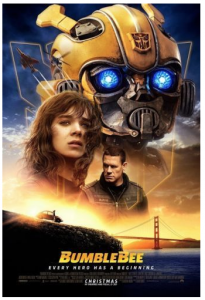By Charly SHELTON
Bumblebee, the second-in-command of Optimus Prime’s Autobot resistance, is a big part of the Transformers mythos and franchise. Originally known as B-127, this Cybertronian warrior was a very different bot than the one we meet in 2007’s “Transformers” film. After five films centered around an ensemble cast including Optimus Prime, Ratchet, Sideswipe, Ironhide, Megatron, Starscream and more, as well as some humans, it is finally time to see Bee take center stage and hear his story of how Autobot warrior B-127 became the lovable and childlike Bumblebee.
At the fall of Cybertron, Optimus Prime charges his lieutenant B-127 to seek out Earth and keep the planet safe, hoping to build an Autobot resistance base on the planet. When B-127 arrives on Earth, he finds he has been followed and, in an ensuing battle, he loses his vocal synthesizer and his memory banks are corrupted. Reverting to a sweet, childlike state and without the ability to communicate, B-127 is revived and befriended by Charlie (Hailee Steinfeld) who dubs him Bumblebee.
Hunted by the government and the Decepticons who followed him to Earth, and with no memory of who he is or how he got there, Bumblebee and Charlie embark on a journey of self-discovery that makes each of them stronger for having known each other. This Transformers film is less about fast cars and explosions like the other films, and more about the love and support of two friends who need someone to turn to.
Kids of the 1980s grew up with Transformers. Whether or not a fan of the cartoon series and toys, they were omnipresent and a part of life. Most have seen the show at least once, and probably had a toy or two from one of the many, many lines of robots that turn into something else – be it a car, a gun, a boombox or even African animals or dinosaurs. Transformers were everywhere. Now, for a new generation, Transformers are again part of every child’s life in one way or another. And the films, while fun and exciting, lack some aspects that the cartoon series had – specifically, real comradery between these Autobot soldiers who fought a generations-long war on Cybertron. Now with “Bumblebee,” we get his origin story and, while that’s fine for the franchise, it does something more than that. It shows, in a small way, the connection in fandom between the Generation 1 (TV show) fans and the new movies fans.
The war on Cybertron is shown in flashbacks to set up how Bee got to Earth. Cool robot fights and all that, but what is really important is the way the characters were handled. Optimus Prime, Bumblebee, Starscream, Soundwave and more classic Transformers are all shown to look like they did in the show – rather basic in design, almost blocky, which saved on animation time and plastic parts for the original concept in 1984. But seeing the original Optimus and Bee, before the new films took place, and seeing that they look like the Optimus and Bee that I grew up with, is a huge deal. Hearing Bumblebee’s voice so much like it was in the show, and the conversation between him and Optimus before he lost his voice, is just like I remember. I had the toys as a kid but only became a fan of the show as an adult, thanks in part to the revival in popularity through the films. But I still remember watching the show in the early 1990s when it was on and that little connection to my childhood memories – seeing my Optimus and Bee – made a big difference for me as a viewer.
This is a movie about heart, and remembering the past. It’s too bad all the Transformers films couldn’t have this much substance, because it’s a fine film on its own and shows the potential of what these films could have been. Let’s hope for the future that this will wake up the main franchise filmmakers to do better.
Rated PG-13, I give this film 4 out of 5 stars.

